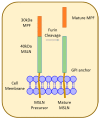The Impact of Mesothelin in the Ovarian Cancer Tumor Microenvironment
- PMID: 30134520
- PMCID: PMC6162689
- DOI: 10.3390/cancers10090277
The Impact of Mesothelin in the Ovarian Cancer Tumor Microenvironment
Abstract
Ovarian cancer is the deadliest gynecological disease among U.S. women. Poor 5-year survival rates (<30%) are due to presentation of most women at diagnosis with advanced stage disease with widely disseminated intraperitoneal metastasis. However, when diagnosed before metastatic propagation the overall 5-year survival rate is >90%. Metastasizing tumor cells grow rapidly and aggressively attach to the mesothelium of all organs within the peritoneal cavity, including the parietal peritoneum and the omentum, producing secondary lesions. In this review, the involvement of mesothelin (MSLN) in the tumor microenvironment is discussed. MSLN, a 40kDa glycoprotein that is overexpressed in many cancers including ovarian and mesotheliomas is suggested to play a role in cell survival, proliferation, tumor progression, and adherence. However, the biological function of MSLN is not fully understood as MSLN knockout mice do not present with an abnormal phenotype. Conversely, MSLN has been shown to bind to the ovarian cancer antigen, CA-125, and thought to play a role in the peritoneal diffusion of ovarian tumor cells. Although the cancer-specific expression of MSLN makes it a potential therapeutic target, more studies are needed to validate the role of MSLN in tumor metastasis.
Keywords: CA125; mesothelin; ovarian cancer; tumor microenvironment.
Conflict of interest statement
The authors declare no conflict of interest.
Figures


References
-
- Meinhold-Heerlein I., Fotopoulou C., Harter P., Kurzeder C., Mustea A., Wimberger P., Hauptmann S., Sehouli J. The new who classification of ovarian, fallopian tube, and primary peritoneal cancer and its clinical implications. Arch. Gynecol. Obstet. 2016;293:695–700. doi: 10.1007/s00404-016-4035-8. - DOI - PubMed
-
- Choi J. Ovarian epithelial cancer: Etiology and pathogenesis. Biowave. 2008;10:32.
Publication types
Grants and funding
LinkOut - more resources
Full Text Sources
Other Literature Sources
Research Materials
Miscellaneous

